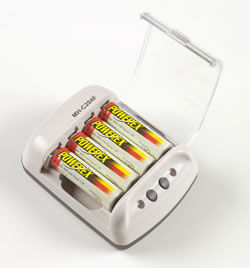
*Rechargeable Batteries and Chargers*
Every day I listen to a small radio at work, it operates on two AA batteries. My FRS radios work on AA batteries, my 2-meter radio works on AA batteries, many of my flashlights (especially those I keep in my attache' or belt kit work on AA batteries. We have become dependant on batteries for many of our hand-held electronic goodies like - radios, CBs, HAM radios and other convenient electronic toys. In an emergency these hand-held devices could become very important to help us, our families or others. It is important to keep some spare batteries on hand and in your kit so that when necessary, you can replace the batteries and get your radio or whatever back on line so you can use it. How long will your spares hold out? Sooner or later we need to think about rechargeable batteries and their long term reliability. A well prepared person will have a combination of both Alkaline and rechargeable batteries and the means to recharge them available. I have been looking at a variety of rechargeable AA batteries and chargers. The following is a summary of what I have found and notes from my research on the internet.
Basic Battery Types:
Nickle Metal Hydride - Nimh
Pros - 300-1000 recharge/discharge cycles capable, no memory effect, highest capacity available (up to 2000 mAh, 1700 seems best performance for cost currently)
Cons - not good for shelf storage of charged battery unless stored in freezer.
Nickle Cadmium - NiCd
Pros - 300 or more recharge/discharge cycles capable, easily charged on "solar" rechargers
Cons - NiCd batteries use Cadmium, a highly toxic heavy metal, that can damage the environment if not disposed of properly; memory affect; not good for shelf storage of charged battery.
Alkaline -
Pros - Excellent shelf life of charged battery as much as 5-6 years.
Cons - Normally not rechargeable, those that are do not compare in relation to the recharge cycles of even the NiCd battery.
Lithium Ion - Li
Pros - Fantastic shelf life of charged battery as much as 12 years for some brands.
Con - High cost, most are not currently rechargeable, disposability problems similar to NiCd batteries.
Lead Acid -
Pros - Fair shelf storage of charged battery (not as good as Alkaline).
Cons - Usually large and heavy, hydrogen gas expelled during charging, acid spills can be damaging.
Battery Charger/Re-charger Types: There are a number of different battery chargers available; the circuit controlled, timer controlled, temperature cut-off controlled and for want of a better name the "U-monitor" type. All charging of batteries involves a certain amount of heat from the resistance to the voltage and amperage going through the battery. If the charging amperage is high then the heat will be high. A little heat is not a problem, but excessive heat can cause damage to the battery, and at best result in the battery failing before its normal life cycle is exhausted, at worst it might burst (or explode) making a mess and possibly cause injury. A basic explanation of the different types and examples are:
Circuit controlled - this method uses a "computer" circuit to monitor the charge level of a battery. All batteries will indicate a steady increase in voltage as they are charged until it has accepted all the charge it is capable of holding. When it reaches this point the battery "tops-off" and actually starts to decrease in total voltage (also called negative Delta V or -dV). With as little as .01 to .05 volt decrease (depending on manufacturer) the charge monitoring circuit shuts down the charging circuit. In some devices it may actually lower the charging voltage to a "maintaining" charge or trickle charge. These are considered to be the best chargers. Examples of this type are the Maha C204F, and the Ray-O-Vac one hour charger (in my tests the Ray-O-Vac definitely overheats the batteries and needs a fan to help cool the batteries during the charge cycle).
Timer controlled - This is by far the most found charger. They usually require a longer charge time of between 6-24 hours for a 1600mAh battery. These can be identified by reference to specific charge times rather than approximate charge times. Most are designed for a specific battery capacity (which is usually included in the package). When used to charge other capacity battery they usually result in an over or under charged battery. An example is the NoMemPro, Radio Shack models and most Eveready chargers. Also if you put a battery that is only slightly discharged it will be overcharged by the timer controlled types.
Temperature cut-off controlled - As the name indicates this charger type monitors the temperature of the battery being charged and when it reaches a trigger temperature cuts the charging circuit. This is not one of the better methods, because the temperature of a battery is dependent upon the charging voltage, amperage and the chemical composition of the battery. It is less scientific and some batteries may be overcharged before they reach the trigger temperature. Generally NiMH batteries should not get above 115°F when charging. Though these are mentioned on the Internet I could not find an example advertised much less one I could buy and test.
U-monitor - this is my own name for where you have a charger that charges your batteries until you turn it off or you take the batteries off of the charger. These are usually found in cheap automotive battery chargers and in most of the inexpensive solar chargers, specifically the REI 4AA solar charger (manufactured in China) that I have been playing with.
Standard Charging: Also called slow charging at 0.1Capacity (C) standard rate for 14-16 hours will greatly enhance the NiMH battery's service life. Most NiMH batteries can withstand overcharge at 0.1C rate indefinitely. Charging at or below 0.1C rate is suitable across a temperature range from 32°F to 115+°F.
Fast Charging: All NiMH series can be fast charged at rates from 0.5 Capacity (C) to 1C. Fast charge termination measures should be employed. These include: Temperature Cut-Off ( TCO ), Rate-of-temperature rise ( dT/dt - change in temperature over time observed), negative Delta V ( -dV )(where the voltage actually starts to decrease while being charged). A timer control set at 105% of nominal capacity can be used as an additional protection. For maximum capacity, a trickle charge can be applied after fast charging. It is best to trickle charge to top-off at 0.1C for 2 hours or 0.2C for 1 hour. Fast charging can be done at temperatures from 50°F to 115°F.
Charger models I have experimented with:

The Maha C204F seemed to have the best reports for an automated circuit
charger. It seems to provide a balance between speed of charging without overheating the
batteries. Using the auto conversion cable, you could use a 12v automotive battery or your car to
power the charger. This seemed to be the most versatile charger for the buck that I could find.
It will "fast charge" normally in about 2-3 hours depending on charge capacity of the battery and
the starting charge level. I have one and am pleased with its performance so far. I did not notice
any overheating, though the batteries do get warm. I got a 12 volt power cord as an option so I
could charge my batteries from a car system or a 12 volt battery.
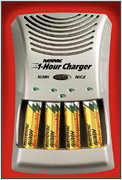
Ray-O-Vac one hour charger . This charger seems to get the batteries too hot
when charging. In fact my research in preparing to write this I found an article that reported
damage done to NIMH batteries from repeated charging cycles using the Ray-O-Vac one hour
charger. According to my research, each time you heat up batteries excessively (over
approximately 115°F) you reduce the capacity of the battery to hold future charges. In effect you
burn it out. I have one and use a fan to help cool the batteries while charging (don't know if it
will help, but will find out).
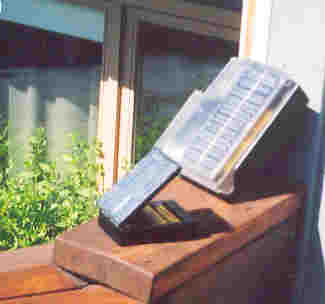
REI Solar-AA battery chargers . The smaller unit in the foreground is from REI
the other one was from NirtoPak I think (both were identified in their literature as being made in
China). These are of the U-monitor type. They provide a charging current based on the sunlight
intensity hitting the solar cell on the hinged top. It is important to keep the solar cells
perpendicular to the sun to maximize the charge rates. The charger in the background took
about the same amount of time to charge 2 batteries as the unit in the front even though it seems
to have a larger solar cell area. The main benefit to the charger in the back is that it also charges
D and C nicads. In my tests it took about 2.5 hours in direct full sunlight to charge two NiCD
AA batteries. There was some heating, but that was due to the sunlight not the charging rate.
The one thing that is important with these units is that they have circuitry to prevent discharging
of the batteries when the sun goes down. I have one of these small units in my BOG. They
aren't the best, but they don't require a plug. The larger unit had a meter installed to indicate the
amount of output from the Solar Cell and an approximate charge time.
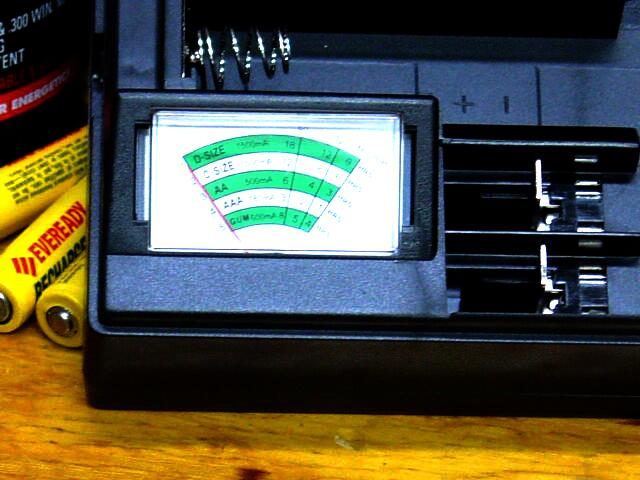
Meter indicates charge time for each battery type
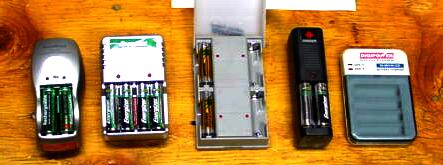
Timer controlled chargers. I have units from Radio Shack, Evereday, Ray-o-vac and Digipower. I found them to recharge the battery types and capacity they were sold with acceptably, albeit over a number of hours. Some took up to 13 hours while the majority were 8 hour chargers. All of these came with Nickle Metal Hydride batteries with capacities from 1500 to 1700 mAh. Each requires a 110V power source to charge. They did their jobs but I much preferred the Maha C204F both because it was faster and because it was controlled by the actual charge state of the batteries being charged.
Some other notes from my research:
NiMH batteries are listed to produce 1.2v for normal use. You can safely use NiMH batteries without any problems in most electronic equipment. Actually when they are fully charged they will measure around 1.4v per cell. NiMH batteries are fast becoming the most popular choice because these batteries have a much higher capacity and are virtually memory free. They do not need to be discharged every time before recharging. NiMH batteries can be damaged from heat by overcharging but this is easily avoided by using a high quality, microprocessor controlled battery charger (like the Maha C204F) or a charger designed for both NiMH and the specific capacity batteries and charging as directed.
Because NiCd and NiMH batteries lose their charge when just sitting on a shelf, they are not normally shipped charged. Even if they were they would lose about 1% - 4% of their charge daily just sitting on a shelf. Rechargeable batteries will deteriorate over time like any battery, even the one in your car, some capacity will be lost after a certain amount of time. If you have had rechargeable batteries stored on the shelf you should plan on fully charging them before use. New batteries will need to be tempered by charging them, and using them, then recharging again at least three charge/discharge cycles before they will perform within "normal" expectations. Also keep in mind that even when used on a regular basis, some capacity is lost with each cycle, although very small. Current manufacture NiMH batteries are designed to have a much longer cycle life than older generation NiMH batteries. Normally after 300-400 cycles, battery capacity will have decreased 10 to15%. Keep in mind that this is the amount of charge the Batteries will hold not the quality.
Alkaline batteries stored at "room temperature" will retain 90% of their power for years without refrigeration. Under normal circumstances, refrigerating or freezing alkaline batteries will extend their life by less than 5%.
NiMH and NiCd batteries, start to lose power when stored for only a few days at room temperature. But they will retain a 90% charge for several months if you keep them in the freezer after they are fully charged. If you do decide to store your charged NiMH cells in the freezer or refrigerator, make sure you keep them in tightly sealed bags so they stay dry. And you should also let them return to room temperature before using them.
Under normal conditions you can expect any where from 300-1000 charge/discharge cycles from most NiMH batteries. Cycle Life is most dependent upon usage conditions and type of charger used.
You should always make sure all batteries are at the same or very close to the same discharge levels. Never mix NiMH batteries that have different levels of charge. Battery chargers that charge in pairs have no way of knowing which batteries are charged and which ones are not. Failure to follow these instructions when charging your batteries can lead to excessive charging, battery damage or leakage, or even damage to the charger itself. Conditioning a battery requires a charger that automatically performs this function and is recommended for battery packs mostly. NiCd batteries benefit from periodical conditioning, but it is actually not necessary for NiMH batteries. Conditioning involves charging a battery fully and then immediately discharging the battery almost completely then charging again. If done correctly you may be able to restore battery function. Conditioning should only be done occasionally because too much is worse than none at all and should only be done when necessary. ie. when the Batteries fail to charge or operate as they did in the past. Conditioning can reduce the "memory effect" that can become a problem with NiCd batteries.
The most common cause of premature battery failure is overcharging. The type of chargers most likely to cause overcharging are the 5 or 8 hour so-called "rapid chargers". The problem with these chargers is that they really don't have a charge control mechanism. Most of them are simple designs which charge at their full charge rate for a fixed period of time, typically five or eight hours, and then shut off or switch to a lower "trickle" charge rate. If they are used properly, these chargers are fine. If they are used improperly they can shorten a battery's useful life in a couple of ways.
First; suppose fully charged or partially charged batteries are put into the charger. The charger has no way to sense this, so it will give the batteries the full charge it was designed to deliver. It is not unusual to put partially charged batteries into a charger since it's pretty easy to mix batteries up and inadvertently put fully charged batteries into a charger. Do this enough times with one of these battery chargers and the capacity of the battery will start to drop.
Another common situation is for the charge cycle to be interrupted part way through the charge. The charger is unplugged to see how warm the batteries feel or to use the electrical outlet for something else. Then the charger is plugged back in. Unfortunately, this will cause a complete charge cycle to start again, even if the previous charge cycle was almost complete.
The easiest way to avoid these scenarios is to use a smart charger, a charger with microprocessor control. A smart charger can determine when a battery is fully charged and then depending on its design, either shut off entirely or switch to trickle charge. Theoretically a trickle charge is a charge rate that is high enough to keep a battery fully charged, but low enough to avoid overcharging. Many battery manufacturers do not recommend long term (months at a time) trickle charging. If trickle charging is used then the charge rate should be very low or only intermittent. Batteries in UPS (Un-interruptible Power Supplies, used with computers) are an example of a battery that is trickle charged all the time and only once in a while used to power a computer, after a year or two they are "dead" and need replacement. The best smart chargers will only send an occasional pulse charge to the battery once it is charged. They do not apply a continuous low rate of charge. Some battery resellers state that applying a continuous trickle charge of about 1/10th the battery's capacity is not harmful. However, no battery manufacturer condones the practice (see note about UPS above).
Rapid charging does not significantly reduce the life of batteries. As long as it is done using a properly designed, smart charger, most NiMH batteries can be recharged in about an hour without any damage or significant reduction in their life. As long as they are not over heated!
There are a couple of cases where the actual voltage difference between an Alkaline and NiMH battery may be important to you. In the case of a device like a radio transmitter, where a higher voltage can mean a stronger signal, fresh alkaline batteries may be more desirable than a rechargeable NiMH battery. This could also be true for a flashlight, which will be slightly brighter with the initial higher voltage of alkaline cells. These are minor differences and may not be important to you, I believe they are offset by the rechargeable capability of the NiMH batteries. And keep in mind that the alkaline battery only has a higher voltage when it is fully charged. Once it gets to 50% capacity or less, it will be delivering a lower voltage than a NiMH battery.
There are a number of good chargers on the market, Maha makes a number of different
models, also when I was in Radio Shack recently I found a number of computer circuit
controlled chargers, one is for eight batteries at a time. It is a good idea to have a few of the fast
chargers that you can get a number of batteries charged quickly and safely.
Tailgunner
All materials at this site not otherwise credited are Copyright © 1996 - 2002 Trip Williams. All rights reserved. May be reproduced for personal use only. Use of any material contained herein is subject to stated terms or written permission.